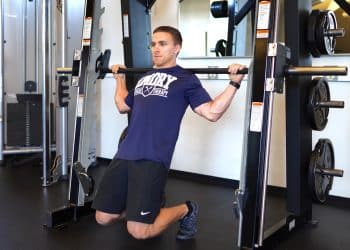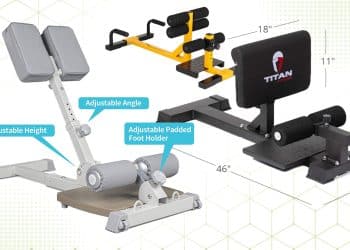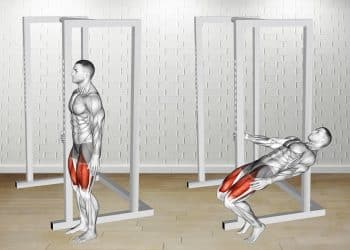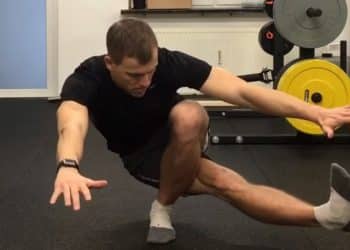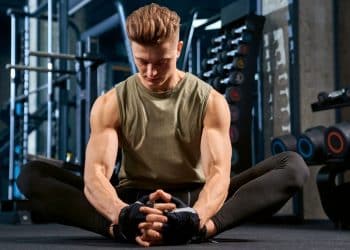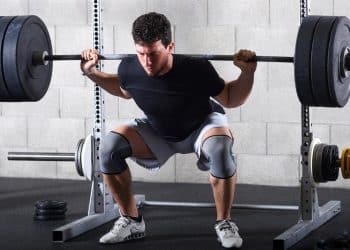As just about every fitness fanatic knows, squats are one of the most effective exercises you can do. Squats build strength and muscle size and can also improve your conditioning and performance for sports.
So, whether you want bigger, more muscular legs, want to lose fat, or run or jump faster, squats really should be part of your training program.
That said, there are lots of different types of squats to choose from, and they all have pros and cons. As such, it’s critical that you do the squat that best matches your fitness goals.
Different squatting variations include:
- Front squat
- Back squat
- Overhead squat
- Air squat
- Hindu squat
- Zercher squat
- Goblet squat
- Split squat
- Squat jump
And now, there is another type of squat to try – the deep knee bend. This is less of a strength and muscle builder and more of a joint mobility and balance exercise. As such, it offers several benefits not generally associated with other types of squats.
In this article, we explain why and how to do deep knee bends and reveal a few variations and alternatives.
Level Up Your Fitness: Join our 💪 strong community in Fitness Volt Newsletter. Get daily inspiration, expert-backed workouts, nutrition tips, the latest in strength sports, and the support you need to reach your goals. Subscribe for free!
Deep Knee Bends – Muscles Worked
The deep knee bend is a compound exercise, meaning it involves several joints and muscles working together. In fact, it would be safe to say that the deep knee bend works your entire lower body. That said, the main muscles involved in deep knee bends are:
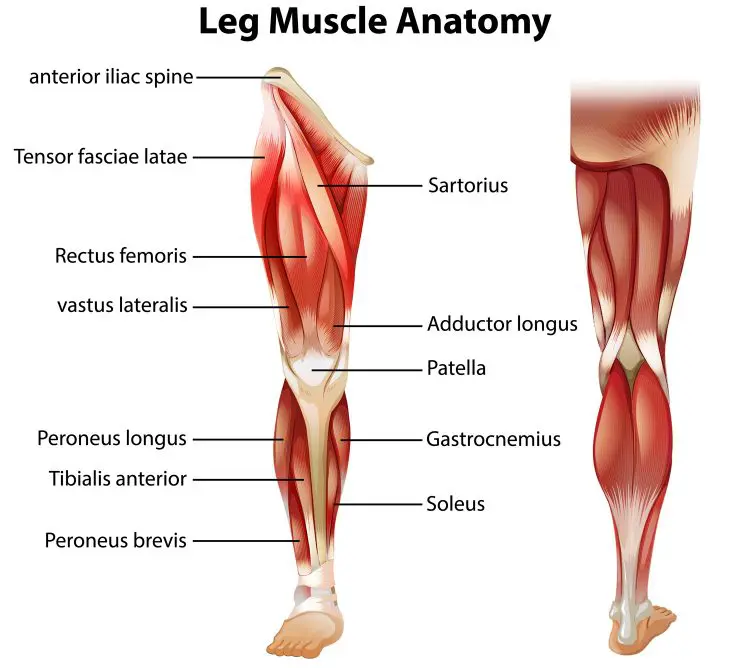
Quadriceps – the four quadriceps muscles are rectus femoris, vastus lateralis, vastus medialis, and vastus intermedius. Known as the quads for short and located on the front of your thighs, these muscles extend your knees. This is the primary muscle group you’ll feel working during deep knee bends.
Hamstrings – located on the back of your thighs, the hamstrings are responsible for knee flexion. There are three muscles within the hamstring group: the semimembranosus, semitendinosus, and biceps femoris.
Triceps surae – this is the collective name for the two muscles that make up your calves: gastrocnemius and soleus. Their main function is the extension of the ankle joint, i.e., pointing your toes. This is a movement called plantar flexion.
Gluteus maximus – known as the glutes for short, gluteus maximus is the largest muscle in the human body. Its primary function is extending your hip. The glutes are located on the back of your hip and pelvis and are basically your butt.
Hip abductors – located on the outside of your hips and thighs, the abductors lift your leg out and away from the midline of your body. The main abductors are gluteus minimus, gluteus medius, and tensor fascia latae.
Hip adductors – the hip adductors draw your leg in toward the midline of your body. Located on the inside of your thighs, the three hip adductors are longus, brevis, and magnus, meaning longest, shortest, and thickest.
Core – deep knee bends are done with a very upright torso. Your core muscles play a small but essential role in maintaining good posture. Core is the collective name for your midsection muscles, i.e., rectus abdominis, obliques, transverse abdominis, and erector spinae. However, these muscles do not need to generate a lot of force, so they don’t receive much of a training effect during deep knee bends.
How to Do Deep Knee Bends
Get more from deep knee bends while keeping your risk of injury to a minimum by following these guidelines:
- Stand with your feet about hip-width apart, toes pointing forward. Pull your shoulders down and back, brace your core, and let your arms hang naturally by your sides. Lengthen your neck and look straight ahead.
- Keeping your torso as upright as possible, bend your legs, and push your knees forward. Allow your heels to naturally lift off the floor as you descend.
- Raise your arms forward in front of you if you wish. This makes balancing easier.
- Squat down as far as you can, ideally until your hamstrings are resting on your calves.
- Stay in this position for as long as required, e.g., 20-40 seconds, and then stand back up again. Alternatively, you can do this exercise for reps, e.g., 6-10.
Deep Knee Bend Benefits and Drawbacks
Not sure if deep knee bends are the right exercise for you? Consider these benefits and then decide!
Anywhere and anytime – with no equipment required, deep knee bends are a very accessible, convenient exercise. You can do them anywhere and anytime, making them useful for breaking up long periods of sitting or standing.
A very functional movement – the deep knee bend used to be an everyday movement. In less modern times, it was a working and resting position, a way to get closer to the ground during tracking and hunting, and a transitional movement from standing to kneeling or crawling. If you spend a lot of time sitting or standing, mastering the deep knee bend could help restore functionality and help you move more fluidly.
Improved mobility – while you can do deep knee bends for reps to build strength and endurance, it’s more commonly used as a mobility exercise. For example, deep knee bends produce a deep stretch in the target muscles, especially the quadriceps and calves. If you want to improve mobility for sports, or so you can do ass to grass (ATG) squats, deep knee bends could help.
Better balance – squats generally involve supporting your weight along the length of your feet. With deep knee bends, all your weight rests on the balls of your feet. This is a much smaller area, which makes it harder to balance. With practice, you should find it easier to maintain your balance, and better balance is critical for sports. Deep knee bends could also reduce your risk of falling over.
While deep knee bends are a mostly beneficial exercise, there are also a couple of drawbacks to consider:
Knee joint stress – while most kids have no problem doing deep knee bends, years of sitting in chairs means that some adults may not be able to do them, and trying could even cause knee joint pain.
Proceed cautiously if you have a history of knee joint pain or doing this exercise causes soreness. Even if you have healthy knees, don’t do too many deep knee bends too soon. Instead, introduce this exercise gradually to avoid unnecessary aches and pains.
Lack of balance – like strength and flexibility, balance tends to decrease with lack of use. As such you may find that you lose your balance during deep knee bends. While your balance will improve with practice, you can get around this problem by raising your arms in front of you as you descend or leaning against a wall until you can maintain your balance unaided.
7 Deep Knee Bend Variations and Alternatives
Deep knee bends are an effective lower body mobility, strength, and balance exercise, but that doesn’t mean you need to do them all the time. There are several variations and alternatives you can use to keep your workouts productive and interesting:
Level Up Your Fitness: Join our 💪 strong community in Fitness Volt Newsletter. Get daily inspiration, expert-backed workouts, nutrition tips, the latest in strength sports, and the support you need to reach your goals. Subscribe for free!
1. Deep knee bend to flexed foot kneel
If you’ve mastered the basic deep knee bend, this exercise is the next logical progression. It teaches you how to transition from a squat to a kneeling position and back again. In the process, you’ll get an even better mobilizing effect in your ankles and knees.
How to do it:
- Stand with your feet about hip-width apart, toes pointing forward. Pull your shoulders down and back, brace your core, and let your arms hang naturally by your sides. Lengthen your neck and look straight ahead.
- Keeping your torso as upright as possible, bend your legs, and push your knees forward. Allow your heels to naturally lift off the floor as you squat. Descend until your knees as resting on the floor. Sit on your heels for a few seconds.
- Shift your weight backward and transition from kneeling back into a deep knee bend. Maintain this position for a couple of seconds.
- Move back into a kneeling position and repeat.
2. Deep knee bend balance
Deep knee bends are already an excellent balance exercise, but this variation takes things up another notch! Do deep knee bends as before but, this time, stand on a balance beam or similar.
Start with a low, wide balance beam and decrease the width and increase the height as you become more proficient. Eventually, you may progress to doing this exercise on an unstable surface, e.g., a BOSU.
3. Deep knee bend forward walk
Also known as the duck walk, this exercise increases the balance, mobility, and coordination effect of deep knee bends. This is an excellent preparatory exercise for Olympic lifting, overhead squats, and any other activity requiring excellent lower body mobility.
How to do it:
- Stand with your feet about hip-width apart, toes pointing forward. Pull your shoulders down and back, brace your core, and let your arms hang naturally by your sides. Lengthen your neck and look straight ahead.
- Keeping your torso as upright as possible, bend your legs, and push your knees forward. Allow your heels to naturally lift off the floor as you squat.
- Shift your weight over onto one foot and, without standing up, move your other leg forward.
- Continue moving forward for the required distance, duration, or number of steps.
4. Hindu squat
The Hindu squat is a variation of the deep knee bend. It’s traditionally used by Indian and western wrestlers as a conditioning exercise. The Hindu squat combines an upper-body movement with the leg action to work virtually every muscle in the body, but just like regular deep knee bends, it’s also great for developing better balance and mobility. Done for high reps, this exercise also produces a welcome cardiovascular conditioning effect.
How to do it:
- Stand with your feet about hip-width apart, toes pointing forward. Raise your arms out in front of you so they’re parallel to the floor. Lengthen your neck and look straight ahead.
- Breathe in and “row” your hands into your shoulders.
- Next, bend your legs and squat down as deep as possible while simultaneously reaching down and back with your arms. Allow your heels to lift off the floor as you descend.
- Raise your arms forward and back up to parallel as you drive your feet into the floor and stand back up. Lower your heels back to the floor as you ascend. Exhale as you return to standing.
- Repeat without pausing.
- Hindu squats should be performed smoothly and in time with your breaths.
5. Asian squat
Like the deep knee bend, the Asian squat is a natural movement that’s also an exercise. However, where the deep knee bend is usually done with a narrow stance and heels raised, the Asian squat involves a wider stance, and your heels stay on the floor.
The wider Asian squat means that your hip abductors and adductors are more involved, which, for some people, may mean it’s a more beneficial exercise.
How to do it:
- Stand with your feet a little more than shoulder-width apart, toes turned slightly outward.
- Bend your legs, push your knees out, and squat down until your hamstrings are resting on your calves.
- Hold this position for 10 to 20 seconds. Make sure your heels stay flat on the floor, and your buttocks are as low as possible.
- Stand up, rest a moment, and then repeat as necessary.
- If lack of balance is a problem, do this exercise next to a wall or while holding onto a waist-high support.
6. Sissy squat
Like deep knee bends, sissy squats involve a large range of motion at the knees while balancing on your toes. However, where deep knee bends are mostly a mobility exercise, the sissy squat is more of a muscle-building exercise. That said, these two exercises involve similar movements and are both excellent for improving balance.
How to do it:
- Stand next to a wall or some other object you can use for balance.
- Rise up onto your tiptoes.
- Push your hips and knees forward and squat down as you simultaneously lean back. Descend as far as you can, ideally until your shins are roughly parallel to the floor.
- Drive your toes into the floor and stand back up.
- Tense your quads and glutes at the top of each rep and repeat.
7. Pistol squat
This pistol squat is a deep single-leg squat. As such, it’s a useful progression if you’ve mastered deep knee bends and are looking for a way to develop strength as well as balance and mobility. Be warned – this is a challenging exercise, so don’t be surprised if you don’t get it right away. If necessary, you can use your arms for assistance to make it more manageable.
How to do it:
- Stand with your feet together and raise your arms out in front of you for balance.
- Shift your weight onto one leg. Bend your supporting knee and squat all the way down while keeping your other leg extended out in front of you. Keep your torso as upright as possible.
- Keeping your arms extended in front of you, drive your foot into the floor and stand back up.
- Repeat for the desired number of repetitions and then do the same number of reps with the opposite leg.
Deep Knee Bends – Wrapping Up
The deep knee bend used to be a staple exercise performed by physical culturists the world over. It also used to be a movement that most people did many times a day. However, it’s gradually been replaced by parallel squats, leg presses, etc., and, as such, the deep knee bend has lost much of its popularity.
In fact, if you do deep knee bends, you may even be told that you are “squatting wrong” or that you are going to hurt your knees, neither of which is true.
There is a saying in fitness: use it or lose it. If you want to maintain your ability to squat deep and move your joints through their fullest range of motion, that’s what you need to do in training.
So, if you want to preserve your mobility and balance, you need to use those fitness components in your workouts. Deep knee bends are one way to do this.
Deep knee bends are a highly beneficial exercise but be warned, if you aren’t used to them, doing too many too soon could leave you with sore knees.
That said, providing you’ve got healthy joints and introduce them gradually, the deep knee bend could be ideal exercise to restore and maintain lower body mobility and balance.
Interested in measuring your progress? Check out our strength standards for Overhead Squat, Zercher Squat, Goblet Squat, and more.


